John Hurrell – 14 March, 2015
With his Tubular Poem scheme, the text (be that flowing sentences, staccato phrases, or disparately unconnected words) is a ribbonlike continuum that spirals around each cylinder, starting at the bottom edge and worming its way to the top. As long as the reader can keep turning the cylinder in her or his hand, and mark the latest ‘place of speech' with a finger, the text need never pause.
Retired Art History professor, author of innumerable articles on aspects of NZ (and books on French) art history, L=A=N=G=U=A=G=E poetry enthusiast and poet himself, and co-editor in the mid 80s of Parallax and Splash magazines, Tony Green presents an exhibition in the Audio Foundation of his Tubular Poems. While text is their main ingredient (they are objects to be picked up and read from) these items can also be seen as portable sculptures - and with their decorated surfaces, paintings or collages.
Displayed in the small gallery next to the office, and mostly arranged on ten low tables positioned against the walls, over two hundred Poems (made over a period of about eight years) are displayed for visitors to sort through and examine. Though they are serious in their exploration of language, their bright colour and bannerlike furling of text gives them a vague circusy feel. They could almost be miniature poster kiosks for a carnival.
There is an amazing range of investigative work here. These works occupy a space between Tibetan prayer wheels and the motorised ‘poem machines’ of the London-based artist Liliane Lijn, who came out to New Zealand with her work in 1998. However Lijn is about the moving text, its speedy blur and how that affects reading and perception. Green is very different, being about literature and a search for a format where recorded language is not a block on a page, a situation where the shape of the page has unfortunate consequences concerning the articulation of sequences of words. The reader has to constantly double back from the right-hand edge to the left to keep tracking in parallel lines.
With his Tubular Poem scheme, the text (be that flowing sentences, staccato phrases, or disparately unconnected words) is a ribbonlike continuum that spirals around each cylinder, starting at the bottom edge and worming its way to the top. As long as the reader can keep turning the cylinder in her or his hand, and mark the latest ‘place of speech’ with a finger, the text need never pause. And, as some of these works show, different texts can be positioned in parallel on a tube, all (but one at a time) being read without breaking.
The other thing is that the diagonal ribbon of text need not be jammed onto the outside of the canister tightly, but spaced in a manner where words and visual imagery can be more effectively mingled than with conventional pages. Because the tube is comparatively narrow, image and text can only be seen partially at any one time. Looking at the image is a very different procedure from the traditional recto/verso page format. (If fact if I was to quote sections of Green’s writing for this review I would have to use the same tubular method. To inscribe on a page like that which you are reading would not work as an attempted equivalent.)
Yet when you hear Green reading these works, he clearly leaves it up to the reader to discover the line breaks, the intonations and registers of his language. His deliberate lack of punctuation means you have to have a sense (your own radar) of how the words cluster together - or fall apart and prefer isolation.
What is fascinating about Green’s project are the variations within his research. Different tube lengths, thicknesses, widths, weights, shapes; some have texts inside as well as outside (across or around long ways) - or on protruding striplike tabs. One work, Chimney, has no added language at all. Other Green poems - like ‘I’ poems 2x3 remix (15/6/12 & 19/9/12) - are all text, with no added paint or collage on top or below the words. Others - like Blue Bottle remix (1/12/07) - have texts about music and are lavishly beautiful and baroque in their painted surfaces. There is even an inverted vase with a spiralling text, plus a sink cleaning brush with a poem-wrapped handle.
You can also see Green trying out different fonts, or point size and background colours, as well as his own cursive handwriting. There are works made of debarked branches as well, curved bits of text-encased wood that shift their weight in your hand as you turn them over. It’s a process-based show that is more about curiosity and testing than about finding resolution and repeating it. A form of research about reading, and the behaviour of words when positioned within a new structure. What they then give to us.
John Hurrell
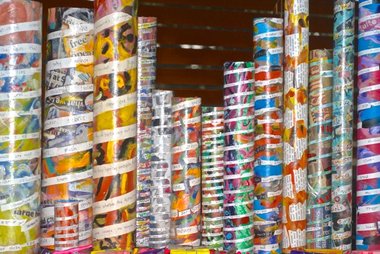
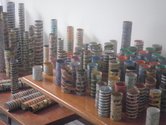
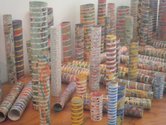

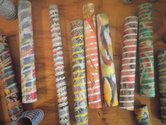
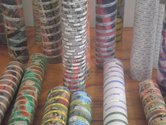


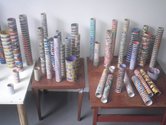



 Advertising in this column
Advertising in this column Two Rooms presents a program of residencies and projects
Two Rooms presents a program of residencies and projects



This Discussion has 0 comments.
Comment
Participate
Register to Participate.
Sign in
Sign in to an existing account.